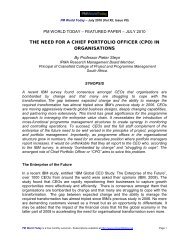Information Measurement Theory (IMT) - Performance Based ...
Information Measurement Theory (IMT) - Performance Based ...
Information Measurement Theory (IMT) - Performance Based ...
Create successful ePaper yourself
Turn your PDF publications into a flip-book with our unique Google optimized e-Paper software.
CHAPTER 2: INFORMATION MEASUREMENT THEORY (<strong>IMT</strong>)<br />
author asserts that the purpose of information-based systems is to communicate<br />
accurate information which is in simplistic terms that everyone can understand. The<br />
author will use the term “dominant” information. Dominant information can be<br />
understood by almost everyone due to its simplicity and it does not require technical<br />
knowledge. Dominant information can be described as a no brainer, common sense,<br />
easy to understand, or where there is no requirement to use one‟s unique experience<br />
to validate a concept. The motivation behind the employment of this technology is to:<br />
1. Minimize the use of data to dominant data<br />
2. Identify the best value or best alignment of resources<br />
3. Minimize decision making and risk<br />
<strong>Information</strong> <strong>Measurement</strong> <strong>Theory</strong><br />
The author developed the <strong>Information</strong> <strong>Measurement</strong> <strong>Theory</strong> (<strong>IMT</strong>) during the last thirty<br />
six years. <strong>IMT</strong> was first published in 1991 at Arizona State University as the structure for<br />
optimizing the effectiveness of information by creating “easy to understand”<br />
information environments (See Attachment 2.1). The purpose of <strong>IMT</strong> is to:<br />
1. Minimize subjective decision-making through the use of dominant information.<br />
2. Minimize the amount of data required to accurately transfer information.<br />
3. Identify the relationship between information usage, processing speed, and<br />
performance.<br />
4. Identify a structure that minimizes the requirements for decision making, direction,<br />
and control of another entity.<br />
5. Optimize processes by identifying and removing entities which increase risk and<br />
add no value (i.e. any party making decisions, directing, and controlling another<br />
party, with no accountability or risk).<br />
<strong>IMT</strong> can be defined as: “A deductive, logical, and dominant explanation of an event.<br />
It includes the use of relative and related data to create information that predicts the<br />
future outcome of the event.”<br />
There are two major methods of problem solving accepted by the scientific arena:<br />
inductive logic or investigative and deductive logic or confirmatory (Davies 1992).<br />
Inductive logic, also known as the scientific method, follows the sequential steps:<br />
1. Establishing a hypothesis that defines an outcome.<br />
2. Devising an experiment that tests the hypothesis.<br />
3. Conducting the experiment to discover previously unknown information.<br />
4. Identifying whether or not the hypothesis has been validated.<br />
5. Determining under what conditions the test results are repeatable.<br />
Deductive logic is defined as: “The redefining or reordering of existing information to<br />
define an outcome (Davies 1992).” Deductive logic differs from inductive logic in the<br />
following ways:<br />
© Dean Kashiwagi 2010 - 2 - 2





